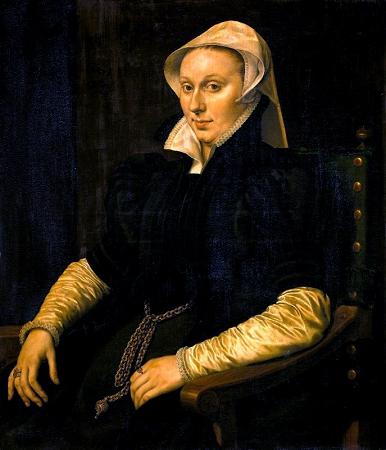Hans Eworth (c1520 - 1574). Hans Eworth was a Flemish painter active in England in the mid-16th century. Along with other exiled Flemings, he made a career in Tudor London, painting allegorical images as well as portraits of the gentry and nobility. About 40 paintings are now attributed to Eworth, among them portraits of Mary I and Elizabeth I. Eworth also executed decorative commissions for Elizabeth's Office of the Revels in the early 1570s. Nothing is known of Eworth's early life or training. As Jan Euworts, he is recorded as a freeman of the artists' Guild of St Luke in Antwerp in 1540. A Jan and Nicholas Ewouts, painter and mercer were expelled from Antwerp for heresy in 1544 and scholars generally accept that this Jan is the same individual. By 1545 Eworth was resident in London, where he is well recorded from 1549. Eworth's earliest surviving works also date from 1549 to 1550. These include the allegorical portrait of Sir John Luttrell with the goddess Pax, commemorating Luttrell's military exploits and the Treaty of Boulogne which finally brought peace between England, Scotland, and France after the long wars known as the Rough Wooing. The original, signed with the HE monogram Eworth consistently used, was donated to the Courtauld Institute of Art by Lord Lee of Farnham in 1932. The painting was in badly damaged condition when it was donated to the Institute, although it has subsequently been conserved and restored. Although there is no direct evidence that Eworth's most important patron was the Catholic queen Mary I, most scholars now accept this to be the case. All his known portraits of Mary I appear to be variants of a portrait in the National Portrait Gallery, London which is signed 'HE' and dated 1554 at the top left. A second portrait, now in the Society of Antiquaries collection, is also signed and dated 1554. Two other portraits show Mary I in later fashions and are thought to have been painted between 1555 and Mary's death in 1558. Another is in the collection of Trinity College, Cambridge. Over the next decade, Eworth continued to paint portraits of the aristocracy, including paired portraits of the Duke of Norfolk and his second wife and of the Earl and Countess of Moray. Despite the frequent appearance of a characteristic HE monogram, the attribution of works to Eworth, and the identification of his sitters, remains in flux. A well-known painting identified by George Vertue in 1727 as Lady Frances Brandon and her second husband Adrian Stokes has now been correctly identified as Mary Nevill or Neville, Baroness Dacre and her son Gregory Fiennes, 10th Baron Dacre. The allegorical painting Elizabeth I and the Three Goddesses, with its slightly different HE monogram, has been variously attributed by Sir Roy Strong as cautiously to The Monogrammist HE in 1969 and more confidently to Joris Hoefnagel in 1987; it is now accepted as the work of Eworth. Eworth's last known works date from 1570-3. Like many other artists of the Tudor court, Eworth was also engaged in decorative work; he was involved in the set design for a masque given by Elizabeth I in honor of the French Ambassador in 1572.
more...








